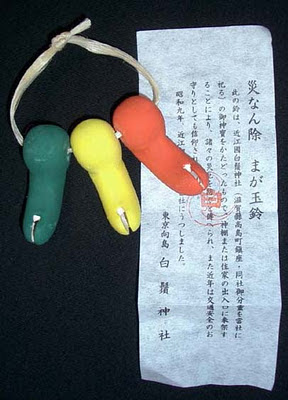::::::::::::::::::::::::::::::::::::::::::::::::::::::::::::::::::::::::::::::::::::::::::::::::::::::::::::::::::::::::::::::::::::
| Magatama 勾玉 Magatama jewel, curved beads Magatama (勾玉 or 曲玉), are curved beads which first appeared in Japan during the Jōmon period.  They are often found in mounded tumulus graves as offerings to deities. They continued to be popular with the ruling elites throughout the Kofun Period of Japan, and are often romanticised as indicative of the Yamato Dynasty of Japan. They are mainly made of jade (翡翠), agate (瑪瑙), quartz (石英), talc (滑石), and jasper (碧玉). Some consider them to be an Imperial symbol, although in fact ownership was widespread throughout all the chieftainships of Kofun Period Japan. It is believed that magatama were popularly worn as jewels for decoration, in addition to their religious meanings. In this latter regard they were later largely replaced by Buddhist prayer beads in the Nara period. Yasakani no Magatama  The most important magatama is the Yasakani no Magatama (八尺瓊曲玉, also 八坂瓊曲玉), which is part of the Imperial Regalia of Japan, added some time around the Heian period. The Yasakani no Magatama stands for benevolence, and is one of the three items used in the ceremony of imperial ascension. In Japanese mythology, the jewels, along with the mirror, were hung on the tree outside of Amaterasu's cave (where she had hidden) to lure her out. It is believed to be a necklace composed of jade magatama stones instead of a solitary gem as depicted in popular culture. It is believed to be enshrined in Tokyo, in the Japanese Imperial Palace. © More in the WIKIPEDIA ! the mirror Yata no Kagami (八咫鏡) . shinkyoo 神鏡 Shinkyo - "mirror of the kami", divine mirror . - quote Magatama and gogok Comma-shaped magatama pendants made of jade as well as other types of stone emerge in Jomon period Japan, and also turn up as gogok in stone cist and dolmen burials in Korea. But magatama emerge earlier in Japan from the middle of the Jomon period (around 5,000 BC)…whereas gogok turn up during the Three Kingdoms period (i.e. during the Yayoi period). Jade magatama have been excavated from ‘Bibi 4 site’ and ‘Wofuki site’ in Hokkaido, ‘Sannai-Maruyama site’ and ‘Kamegaoka site’ in Aomori, ‘Chojagahara site’ in Itoigawa City, Niigata Prefecture and ‘Hanareyama site’ in Nagano - source : heritageofjapan.wordpress.com :::::::::::::::::::::::::::::::::::::::::::::::::::::::::::::::::::::::::::::::::::::::::::::::::::::::::::::::::::::::::::::::::::: - ABC - List of Magatama from the Prefectures ................................................................................. . . . . . . . . . . Fukushima  Kashima Jinja 鹿嶋神社 Kashima Shrine ................................................................................. . . . . . . . . . . Tokyo Shirahige jinja shrine 白鬚神社 magatama suzu 勾玉鈴 3 clay bells in magatama form  If placed at the entrance of the home, they prevent fire and protect from evil. Magatama is seen as a symbol of sun and moon together, or as an embryo in the mother womb. . . . . . . Tsunashiki Tenmangu Shrine 綱敷天満宮 .  bracelet 勾玉(まがたま)腕守り it also comes in red ................................................................................. . . . . . . . . . . Shimane  . Magatama from Izumo . The Izumo region is a famous producer of menoo めのう (瑪瑙) , 出雲めのう agate stone. Many are formed into ritual magatama jewels for the imperial family. 松江市玉湯町 Matsue Town, Tamayu-Cho. . Shinbutsu Pilgrims 神仏霊場巡拝 . get a magatama at the last holy place. ................................................................................. . . . . . . . . . . Yamaguchi  shooryuu magatama omamori 昇龍勾玉お守り Rising Dragon and Magatama amulet To bring you good luck, climb the jewel like a dragon. Shrine Shirasaki Hachimangu 白崎八幡宮 This shrine has a lot more interesting amulets. source : sirasaki-hp.shop-pro 山口県岩国市今津町6-12-23 ::::::::::::::::::::::::::::::::::::::::::::::::::::::::::::::::::::::::::::::::::::::::::::::::::::::::::::::::::::::::::::::::::::  From Ise Shrine . . . CLICK here for Photos ! . Reference . ::::::::::::::::::::::::::::::::::::::::::::::::::::::::::::::::::::::::::::::::::::::::::::::::::::::::::::::::::::::::::::::::::::  Daruma in a plastic magatama :::::::::::::::::::::::::::::::::::::::::::::::::::::::::::::::::::::::::::::::::::::::::::::::::::::::::::::::::::::::::::::::::::: quote - Tsubaki Grand Shrine of America Magatama Omamori Jewlery The MAGATAMA (Jewel) along with the KAGAMI (Mirror) and the TSURUGI (Sword) comprise the SANSHU-NO-JINGI (3 sacred treasure of Shinto). Literally these treasure are known as MIKUSA-NO-TAKARA-MONO. MAGATAMA: the spirallic jewel form of Magatama is the fundamental structure of creation.....from the infinite expanse of the Great Nature, sprouting like a reed comes the primal formation of the spiral form...our human forms echoes this process in the womb....Shinto, from remote antiquity could intuit that all life and growth from the form of Galaxies to the path of photons (light) follow the spiral form of materialization. Mitsudomoe (symbol of Shrine Shinto) can also be called "Mikubitama" and consists of: KUSATAMA = Mission MAGATAMA = Life KUDATAMA = Fate  The meaning of the jewel/magatama is to remind us of this process and enhance our life power. According to O-HARAHI-NO-KOTOBA jewelry made of Magatama, Kusatama and Kudatama twisted with thread of KI represents the Ikutama (signifies an activated soul, coming into awareness) of all things in Onogorojima (self-condensing ball; Earth Ship) and all things in Great Nature. 1) Suisyo, Clear Quartz Crystal...Suisyo is for harmony and protection 2) Pink Suisyo, Rose Quartz Heart, Love, Good relation, the soft pink colour of this quartz leads to kindness and stable emotion. 3) Murasaki suisyo, Amethyst.. Highest colour vibration/ healing stone. 4) Hisui, Jade..Calming, dispell misfortune, bravery in face of adversity, increased patience, protection of love and friendship. MAGATAMA NECKLACE MAMORI - GOSHIKI MAGATAMA NECKLACE MAGATAMA BRACLET MAMORI source : www.tsubakishrine.org/omamori ::::::::::::::::::::::::::::::::::::::::::::::::::::::::::::::::::::::::::::::::::::::::::::::::::::::::::::::::::::::::::::::::::::  俳句 『 勾玉池 』 by 加藤暢一 Haiku "Magatama Ike" Magatama Pond source : nobu-haiku . . . CLICK here for Photos of Magatama Pond ! Magatama Haiku collection "勾玉俳句" ::::::::::::::::::::::::::::::::::::::::::::::::::::::::::::::::::::::::::::::::::::::::::::::::::::::::::::::::::::::::::::::::::::  水色の勾玉にある春の色 mizuiro no magatama ni aru haru no iro in this magatama of the color of water the color of spring Kato Ruriko 加藤瑠璃子 (Katoo Ruriko) |
::::::::::::::::::::::::::::::::::::::::::::::::::::::::::::::::::::::::::::::::::::::::::::::::::::::::::::::::::::::::::::::::::::
. Regional Folk Toys from Japan .
. Tohoku after the BIG earthquake March 11, 2011
[ . BACK to WORLDKIGO . TOP . ]
[ . BACK to DARUMA MUSEUM TOP . ]
::::::::::::::::::::::::::::::::::::::::::::::::::::::::::::::::::::::::::::::::::::::::::::::::::::::::::::::::::::::::::::::::::::

1 comment:
Do NOT post spam to this entry !
Post a Comment